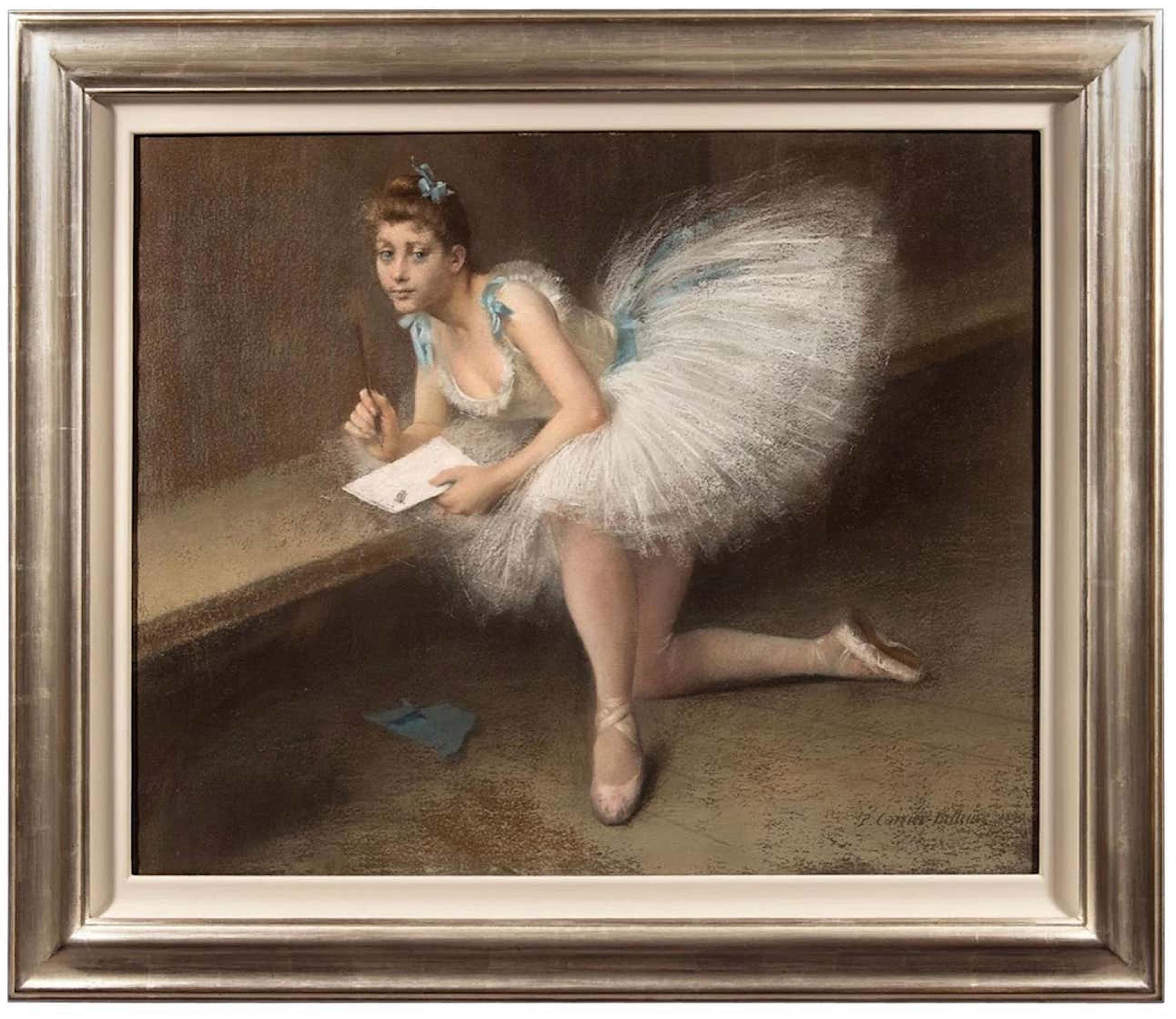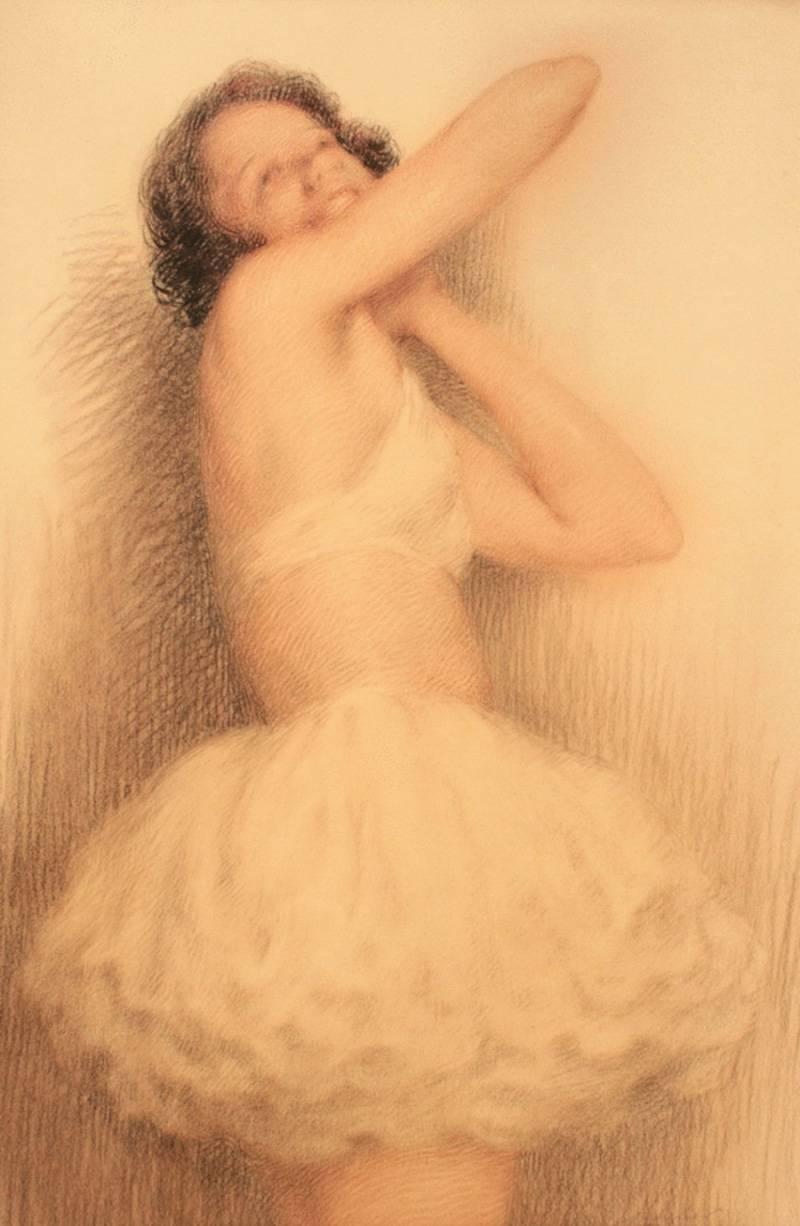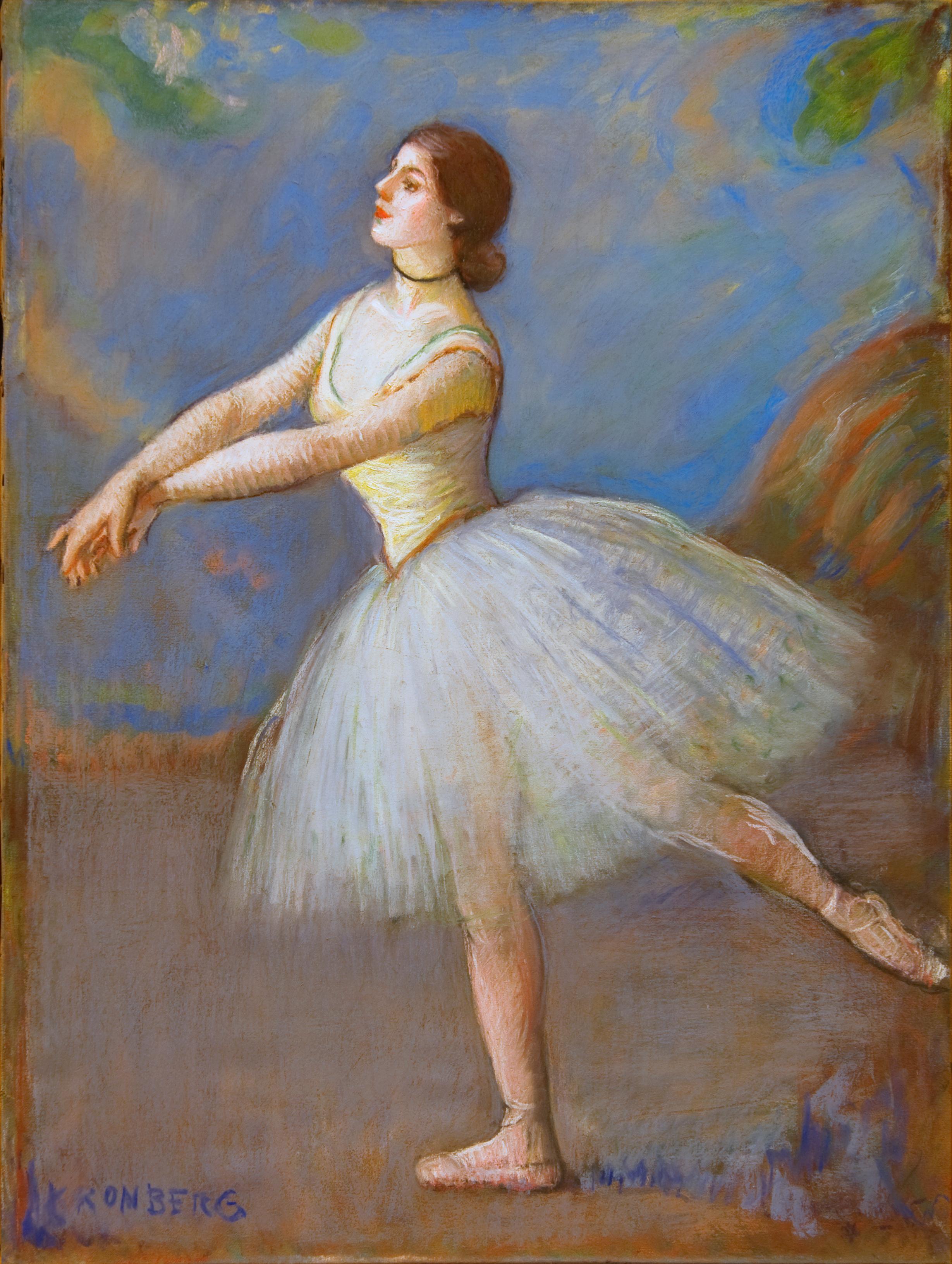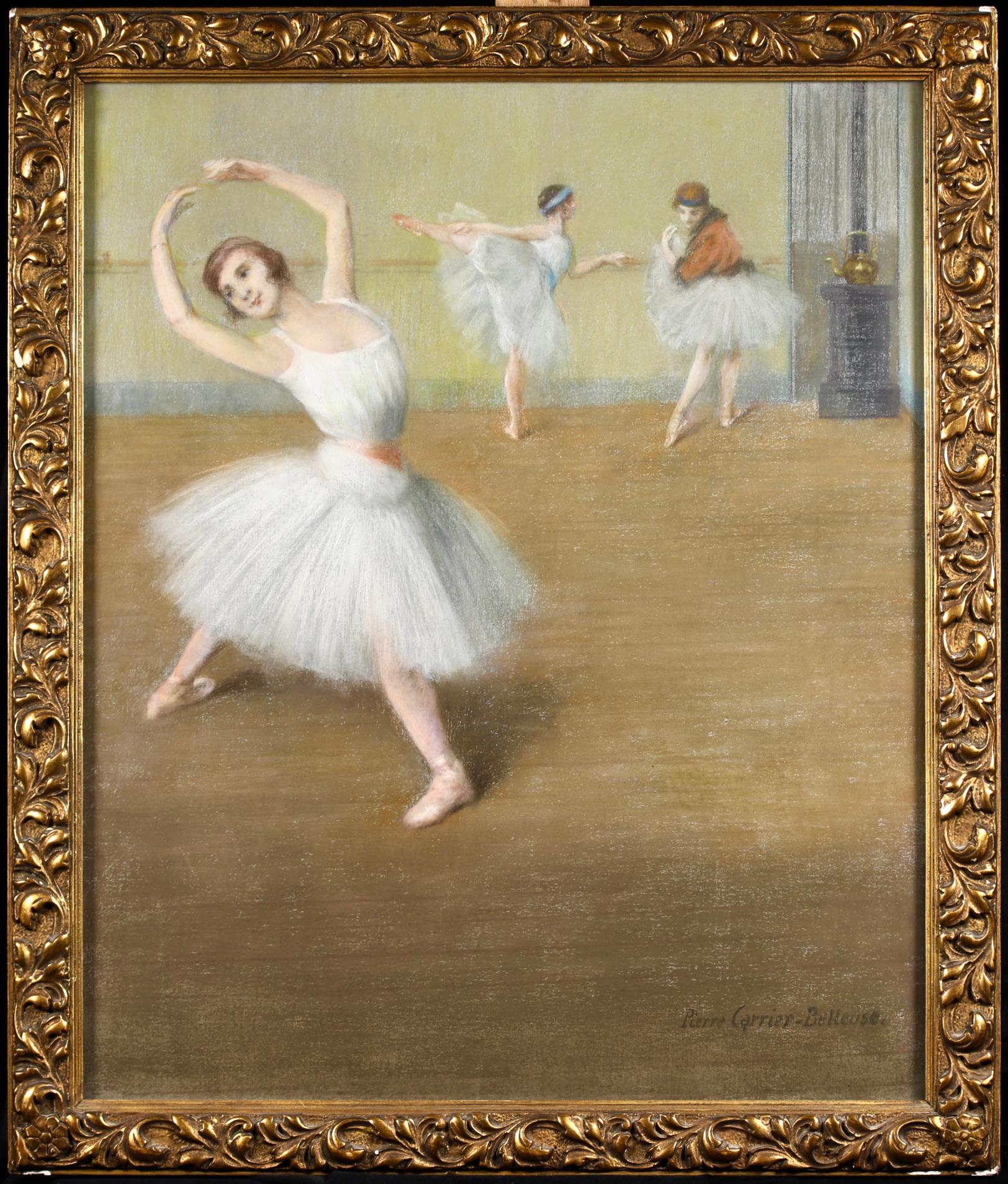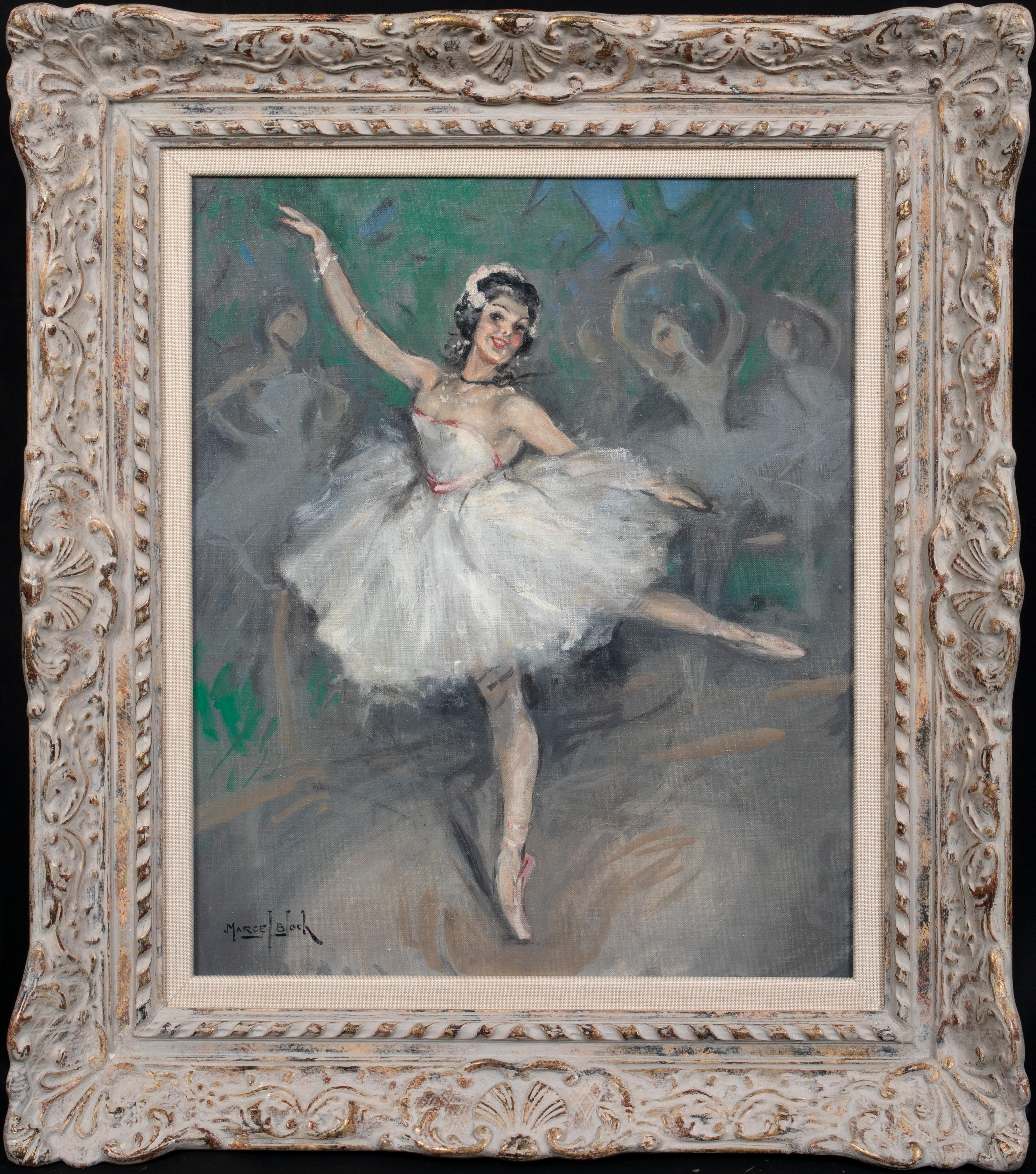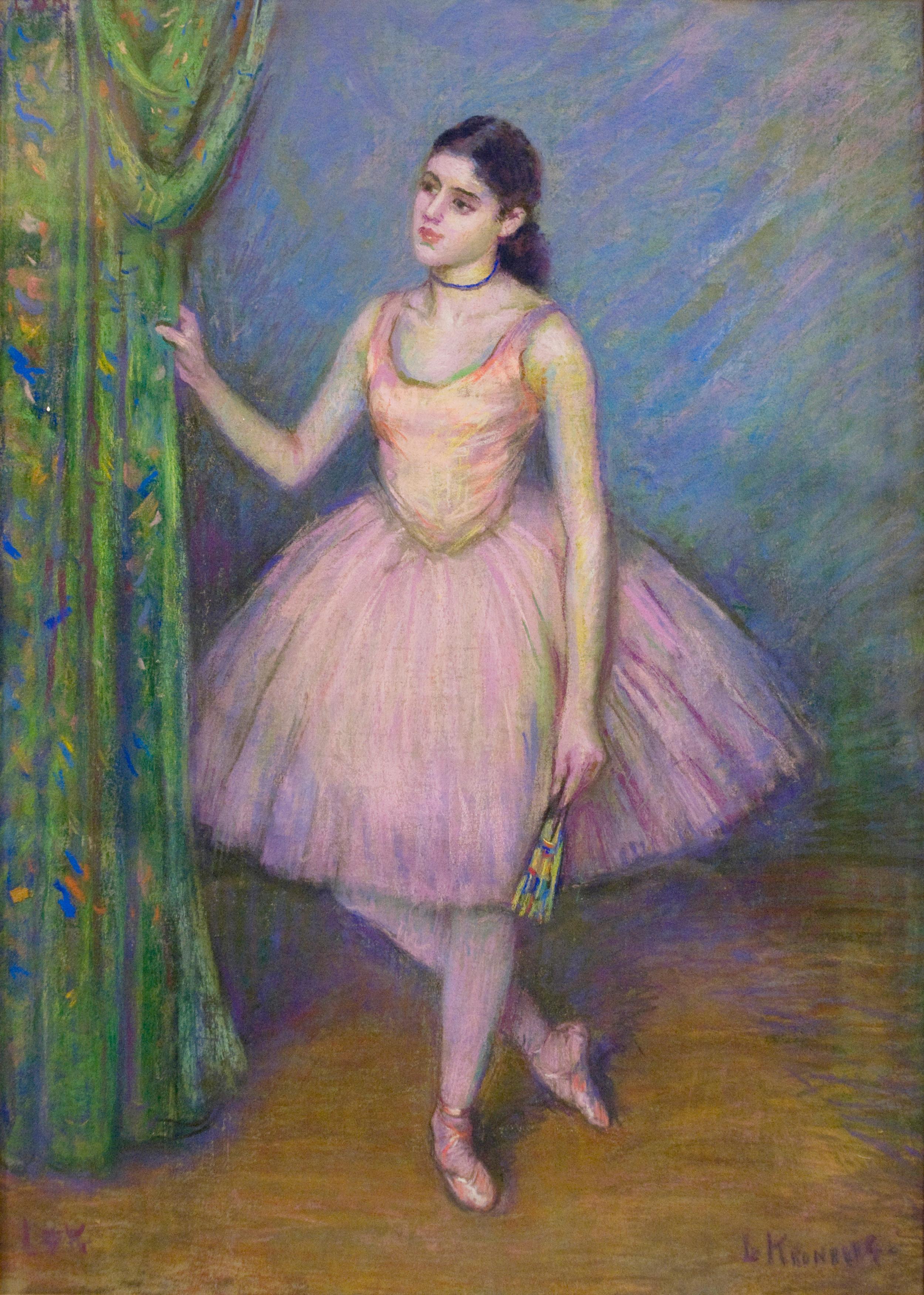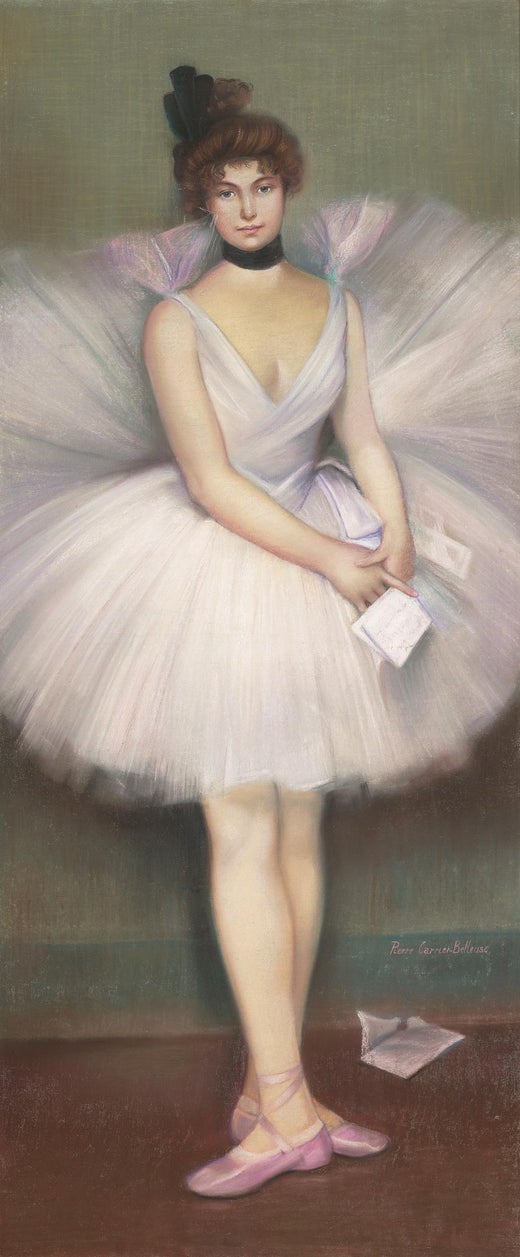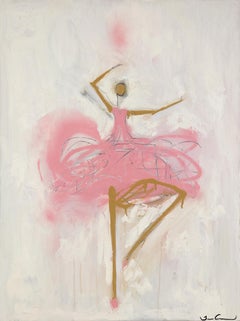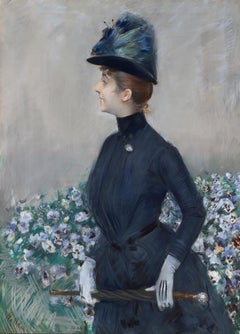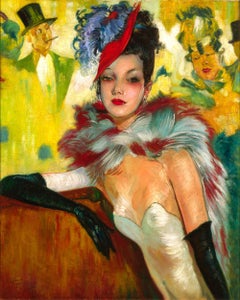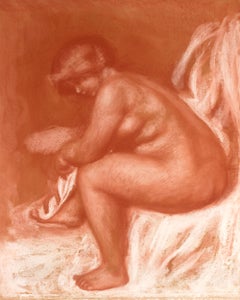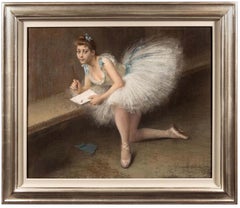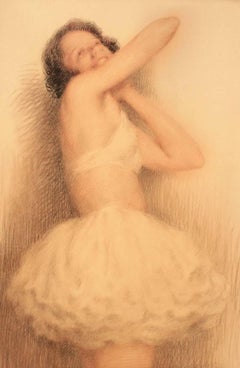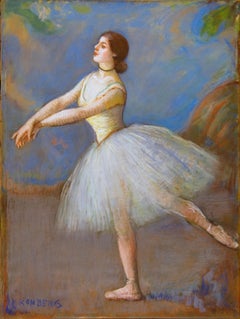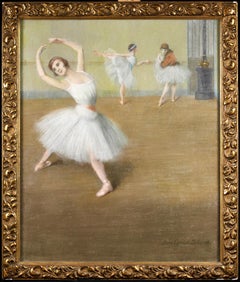Items Similar to Danseuse By Pierre Carrier-Belleuse
Want more images or videos?
Request additional images or videos from the seller
1 of 8
Pierre Carrier-BelleuseDanseuse By Pierre Carrier-BelleuseCirca 1898
Circa 1898
$98,500
£74,335.24
€85,102.61
CA$138,917.66
A$152,514.26
CHF 79,567.02
MX$1,845,634.90
NOK 997,249.04
SEK 939,670.79
DKK 635,268.29
About the Item
Pierre Carrier-Belleuse
1851-1932 French
Danseuse
Signed “Pierre Carrier-Belleuse” (lower right)
Pastel on canvas
Strikingly elegant, this extraordinary pastel by French impressionist Pierre Carrier-Belleuse displays the artist’s mastery of his medium and his fascination with the intimate and graceful world of the modern ballerina. Carrier-Belleuse captures this classic beauty posed in the fourth position and the playful puff of her tutu shimmers with an incandescent glow filling the center of the composition. This dancer is simultaneously graceful and accessible, as her soft features and alluring eyes draw in the viewer. Much like the work of Degas, Carrier-Belleuse’s dancers are depicted with a common beauty that is at once poetic and attainable. A master of the art of pastel, his works are highly collectible as stunning examples of the art of impressionism.
Born in 1851, Carrier-Belleuse was the son of the celebrated sculptor Albert Carrier-Belleuse, from whom he learned his artistic trade at a young age. He also studied under Alexandre Cabanel and Galland at the École des Beaux-Arts, and became a regular exhibitor at the Paris Salon beginning in 1875. Successful during his lifetime, he received an honorable mention at the Salon in 1887 and earned a silver medal at the Exposition Universelle in 1889. He mastered the art of working with pastels and was best known for his scenes of ballet dancers, in addition to his popular landscapes, and historical and genre works.
Circa 1898
Frame: 52” high x 26 1/4” wide
Canvas: 45” high x 20” wide
- Creator:Pierre Carrier-Belleuse (1851-1932, French)
- Creation Year:Circa 1898
- Dimensions:Height: 52 in (132.08 cm)Width: 26.25 in (66.68 cm)Depth: 2.25 in (5.72 cm)
- Medium:
- Movement & Style:
- Period:
- Condition:
- Gallery Location:New Orleans, LA
- Reference Number:Seller: 31-83141stDibs: LU18613779872
Pierre Carrier-Belleuse
Pierre Carrier-Belleuse was one of four artists born to Albert-Ernest Carrier-Belleuse (1824-1887), a thriving sculptor. Pierre studied at the l’Ecole des Beaux-Arts, Paris, under Alexandre Cabanel (1824-1881) and Pierre Victor Galland (1822-1892). The influence of their soft palates and classical style can be seen in the present lot. He exhibited in the Salon de Paris from 1875, receiving an honorable mention in 1887 and a silver medal at the Universalle Exposition in 1889. He flourished in his depictions of Ballerinas, where his favored medium of pastel allowed him to capture the movement of their dance. Carrier-Belleuse enjoyed working on a large scale. Between 1914 and 1916, Carrier-Belleuse and Auguste François-Marie Gorguet proposed, planned and co-created what was considered world's largest painting: Panthéon de la Guerre (45 ft. high and 402 ft. in circumference) containing almost 6,000 portraits, painted mostly from life.
About the Seller
5.0
Vetted Professional Seller
Every seller passes strict standards for authenticity and reliability
Established in 1912
1stDibs seller since 2013
19 sales on 1stDibs
Typical response time: 10 hours
- ShippingRetrieving quote...Shipping from: New Orleans, LA
- Return Policy
Authenticity Guarantee
In the unlikely event there’s an issue with an item’s authenticity, contact us within 1 year for a full refund. DetailsMoney-Back Guarantee
If your item is not as described, is damaged in transit, or does not arrive, contact us within 7 days for a full refund. Details24-Hour Cancellation
You have a 24-hour grace period in which to reconsider your purchase, with no questions asked.Vetted Professional Sellers
Our world-class sellers must adhere to strict standards for service and quality, maintaining the integrity of our listings.Price-Match Guarantee
If you find that a seller listed the same item for a lower price elsewhere, we’ll match it.Trusted Global Delivery
Our best-in-class carrier network provides specialized shipping options worldwide, including custom delivery.More From This Seller
View AllBallerina by Louis Carreon
By Louis Carreon
Located in New Orleans, LA
Louis Carreon
b. 1977 American
Ballerina
Signed “Louis Carreon” (lower right)
Mixed media on canvas
In his Ballerina series, Louis Carreon examines the ambitions and resilience o...
Category
21st Century and Contemporary Post-Modern Mixed Media
Materials
Canvas, Mixed Media
La femme aux fleurs (Portrait de Mathilde See)
By Paul César Helleu
Located in New Orleans, LA
Paul César Helleu is regarded among the most sought-after society portraitists of his era, and his Belle Époque works rival those of his contemporaries John Singer Sargent and Giovanni Boldini. He is best remembered for capturing the era's most beautiful socialites, including Consuelo Vanderbilt, the Duchess of Marlborough, the Comtesse de Loriol Chandieu and the Comtesse Mathieu de Noailles, among others. This work, however, stands out in that it captures the charming likeness of one of his art world cohorts, Mathilde See, a Parisian-born decorator and painter of floral still lifes. She is the essence of the modern woman, captured in her fashionable dress as she strolls along the flower-lined streets of Paris.
Commanding in size, Portrait de Mathilde See fully displays Helleu's mastery over the medium of pastel. The muted palette of greys and blues is typical of the artist, bringing a harmony and cohesiveness to the composition. Furthermore, Helleu cleverly alludes to See's own artistic output with a backdrop of vibrant floral blooms, enlivening the canvas and complementing the greens and blues of the peacock feather adorning her hat.
The portrait is all the more significant thanks to its provenance. It was previously in the collection of A. Alfred Taubman, one of America's most successful entrepreneurs and one-time owner of Sotheby's. Considering Taubman encountered some of the most noteworthy and beautiful works of art ever made through his auction house, the fact that he chose this portrait by Helleu to grace his collection is a testament to its import.
Born in Brittany in 1859, Helleu moved to Paris in 1876 in order to study at the École des Beaux-Arts. Like so many other artists of his generation, he was trained there under the Academic master Jean-Léon Gérôme. That same year, he also attended the Second Impressionist Exhibition...
Category
20th Century Modern Portrait Paintings
Materials
Linen, Pastel
Elegant Lady with Feather Boa by Jean-Gabriel Domergue
By Jean-Gabriel Domergue
Located in New Orleans, LA
Jean-Gabriel Domergue
1889-1962 French
Elegant Lady with Feather Boa
Signed "Jean Gabriel Domergue" (lower left)
Oil on canvas
A radiant masterwork by French artist Jean-Gabriel ...
Category
20th Century Post-Impressionist Figurative Paintings
Materials
Canvas, Oil
Après le bain (After the bath)
By Pierre Auguste Renoir
Located in New Orleans, LA
For Pierre-Auguste Renoir, Impressionism's pre-eminent figure painter, depicting the nude was an exercise in bringing the canvas to life. He once said, “I look at a nude, I see myriads of minuscule shades. I have to find those which will make the flesh on my canvas come to life and resonate.” This compelling portrait by Renoir entitled Après le bain presents the nude figure of a woman in a serene, private moment, absorbed in the task of drying herself after a bath. The artist’s mastery of light and shading is incredible, achieving a sense of vitality in this otherwise ordinary scene.
Renoir is celebrated for his figural work, especially his Rubenesque female nudes, however, it was not until the artist was in his forties that he depicted the nude with any frequency. In 1881, Renoir traveled to Italy, where he studied the works of the Renaissance masters and the ancient art of Pompeii and Rome. Upon his return to France, the nude became his favored subject, and he used the motif to combine the spontaneity of Impressionism with the solid modeling of classical painting. Renoir’s medium here, sanguine, a reddish-brown chalk, was used extensively in the Renaissance by Leonardo (who employed it in his sketches for the Last Supper), Michelangelo and Raphael. Its warm hue lends itself well to depicting flesh, and the chalk drawing allows for a greater focus on line, form and texture in a departure from the aspects of color and light that so often preoccupied the Impressionists. Après le bain conveys the impression of arrested motion with perfect naturalness, deftly capturing the moment before the elegant lines of the sitter's form change position.
The sitter is almost certainly Gabrielle Renard, the nanny to Renoir’s children and a frequent model for the artist. Gabrielle was the cousin of Renoir’s wife, Aline, and came to Montmartre to work for the family at the age of 16. She developed a strong bond with the family and became a favorite subject for Renoir, appearing in several of his most important works, including his 1911 Gabrielle with a Rose (Musée d'Orsay). When Renoir began to suffer from severe rheumatoid arthritis that would eventually leave him unable to walk and scarcely able to grasp a paintbrush, it was Gabrielle that would assist the artist by positioning the paintbrush between his crippled fingers.
Born in Limoges, France in 1841, Renoir began his career as an apprentice to a painter of porcelain wares. He later moved to Paris at the age of 21, enrolling at the prestigious École des Beaux-Arts. It was here, while studying under Charles Gleyre, that Renoir attained a tremendous appreciation for the academic style of painting, a quality that would last throughout his career. This was also when he met Claude Monet and several other classmates, with whom he would later form the Impressionists.
Working closely with Monet, Renoir began experimenting with the portrayal of light and its effect on his canvases. The youngest member of the Impressionist movement, an astute Renoir recognized how a subject was constantly changing due to the dynamic effects of light on color. Relying heavily upon his academic training that focused on composition, lines and descriptive details, Renoir distinguished himself among his contemporaries. His intuitive use of color and expansive brushstroke, along with acute attention to his subject, have placed him among the finest painters in history.
This work is accompanied by a certificate of authenticity and will be included in the forthcoming catalogue raisonné of the work of Pierre-Auguste Renoir from the Wildenstein Plattner Institute.
Circa 1898
Canvas: 43 1/2" high x 35 1/2" wide
Frame: 57 3/4" high x 49 1/4" wide
Provenance:
Galerie Durand-Ruel, Paris (acquired from the artist on January 25, 1899)
J. Pereire Collection, France (1966)
Sam Salz, New York (before 1981)
Claus Virch, Paris
French Compagny, Inc., New York
Larry Silverstein, New York (circa January 1987)
Le Clos de Sierne Gallery, Geneva
Galerie Heyram, Paris (October 1987)
Francis Gross
M.S. Rau, New Orleans
Literature:
B. Schneider, Renoir, Berlin, 1957, p. 95 (illustrated in color, p. 83)
M. Gauthier, Renoir, Paris, 1958, p. 83 (illustrated in color; erroneously dated '1916' and titled 'Woman in her toilet')
F. Fosca, Renoir, L'homme et son obra, Paris, 1961, p. 280 (illustrated, p. 95; erroneously dated 'about 1890' and titled 'After the Bath...
Category
19th Century Impressionist Nude Paintings
Materials
Canvas, Paper, Chalk
Price Upon Request
Josianna, Jeune Femme au Ruban by Jean Gabriel Domergue
By Jean-Gabriel Domergue
Located in New Orleans, LA
Jean-Gabriel Domergue
1889-1962 French
Josianna, jeune femme au ruban
(Josianna, Young Woman With Ribbon)
Signed "Jean Gabriel Domergue" (lower left)
Oil on panel
A young French beauty known as Josianna is the subject of this work by Jean-Gabriel Domergue, and the oil on panel is a perfect example of the portraits for which the artist is renowned. His model embodies the concept of the la belle Parisienne: slender, swan-like women bearing an unmistakable grace and style. Domergue includes a delicate pink ribbon around her neck, suggesting a fashionable garment, set against a soft pastel-colored backdrop. The artist's oeuvre encompasses women from all facets of society, from aristocratic figures such as Liane de Pougy and Nadine, Baroness de Rothschild...
Category
20th Century Post-Impressionist Figurative Paintings
Materials
Oil, Panel
Femme mettant ses bas by Maximilien Luce
By Maximilien Luce
Located in New Orleans, LA
Maximilien Luce
1858-1941 French
Femme mettant ses bas
(Woman putting on her stockings)
Pastel on paper
Signed "Luce 89" (lower left)
Maximilien Luce’s Femme mettant ses bas is a...
Category
19th Century Post-Impressionist Figurative Drawings and Watercolors
Materials
Paper, Pastel
You May Also Like
The Ballerina
By Pierre Carrier-Belleuse
Located in Wiscasett, ME
Pastel on canvas, signed lower right, measuring 38" x 48.25" including the frame. Pierre Carrier-Belleuse His first studies were with his father, the sculptor Albert-Ernest Carrier-...
Category
Early 1900s Impressionist Figurative Paintings
Materials
Pastel
The Ballerina, An Original Pastel Drawing of a Ballerina
By Lucien Boulier
Located in Naples, Florida
Lucien Boulier 1882-1963
Lucien Boulier was born in Verdun, France in 1882. He was a student of Jean Léon Gérôme. He exhibited at the Salon d’Automne from...
Category
Early 20th Century Impressionist Figurative Drawings and Watercolors
Materials
Oil Pastel
Dancer in White
By Louis Kronberg
Located in Mc Lean, VA
American Impressionist
Category
1940s American Realist Figurative Drawings and Watercolors
Materials
Pastel, Cardboard
Danseuses a la barre - Impressionist Figurative Pastel - Pierre Carrier-Belleuse
By Pierre Carrier-Belleuse
Located in Marlow, Buckinghamshire
Signed figurative pastel on canvas circa 1910 by French genre painter Pierre Carrier-Belleuse. The work depicts three ballerinas wearing white tutus, warming up in a studio. Carrier-Belleuse was a contemporary of Edgar Degas and they exhibited simultaneously at the major Salons in Paris. This classic example evokes the Belle Epoque period in french history and is superbly executed.
Signature:
Signed lower right
Dimensions:
Framed: 29"x24"
Unframed: 26"x21"
Provenance:
Private French collection
Pierre Carrier-Belleuse studied at the École des Beaux-Arts in Paris under Alexandre Cabanel and the interior decorative artist Pierre Victor Galland. He started out as an oil painter and produced genre compositions, such as his Final Rendezvous. From 1885, however, he opted to work exclusively in pastel, producing a large number of sketches and portraits but always remaining faithful to his earlier genre compositions. Examples include Pierrot, Harlequin, Woman with Cat. The periodical Figaro Illustré published a large number of his sketches of dancers, a recurrent theme throughout his work.
From 1875, Pierre Carrier-Belleuse exhibited frequently at the Paris Salon, receiving an honourable mention in 1887 and being awarded a silver medal at the Exposition Universelle of 1889.
Museum and Gallery Holdings:
Dunkirk: Dancer Adjusting her Shoe (pastel)
Gray: On the Dunes; In the Sun
La Rochelle: Dancer
Le Puy-en-Velay: Fantasy
Mulhouse: Mule's Bonnet
Paris (Municipal Collection): Tender Vow (pastel)
Versailles...
Category
1910s Impressionist Figurative Paintings
Materials
Canvas, Pastel
Portrait Of A Ballerina, early 20th Century by Marcel BLOCH (1882-1966)
By Marcel Bloch
Located in Blackwater, GB
Portrait Of A Ballerina, early 20th Century
by Marcel BLOCH (1882-1966)
Large early 20th Century French Impressionist portrait of a ballerina, oil on canvas by Marcel Bloch. Good q...
Category
19th Century Portrait Paintings
Materials
Canvas, Oil
Dancer in Pink
By Louis Kronberg
Located in Mc Lean, VA
American Impressionist
Category
1940s American Realist Figurative Drawings and Watercolors
Materials
Pastel, Cardboard
Read More
Paul Revere Crafted This Silver Coffee Pot 250 Years Ago
Perhaps best known as a Revolutionary War hero, Revere was also an accomplished silversmith, and this pot is now available on 1stDibs.
Degas Portrayed These Exuberant Ukrainian Dancers with ‘Orgies of Color’
Discovered in Parisian cabarets, the performers reenergized the artist’s practice.
More Ways To Browse
Antique Ballet
Carrier Belleuse
19th Century Figurative Paintings Dance
Degas Dancer
A Carrier Belleuse
Ballerina Antique
19th Century Watercolor Historical Genre Scene
Juan De Dios
Marcel Mangin
Old Master Sketch
Salvador Dali Drawing
Antique Greek Costume
Chalk Head
Chinese Ink Wash
Chinese Pith Rice Paintings
Dolly Dingle
English Watercolor Study
Frieze Drawing
